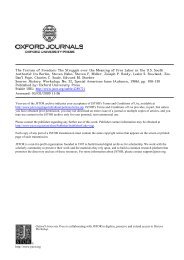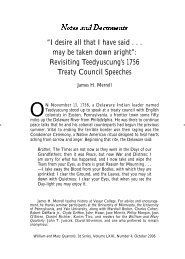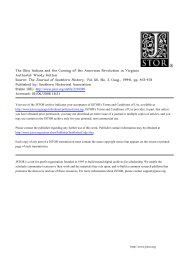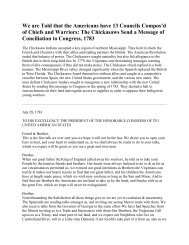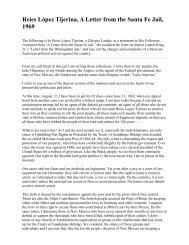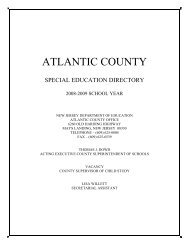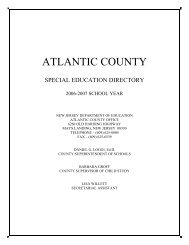A Historical and Regional Overview of Latinas in the United ... - CUNY
A Historical and Regional Overview of Latinas in the United ... - CUNY
A Historical and Regional Overview of Latinas in the United ... - CUNY
You also want an ePaper? Increase the reach of your titles
YUMPU automatically turns print PDFs into web optimized ePapers that Google loves.
Introduction: A <strong>Historical</strong> <strong>and</strong> <strong>Regional</strong> <strong>Overview</strong><br />
Mo<strong>the</strong>r <strong>and</strong> <strong>in</strong>fant, 1949. Courtesy <strong>of</strong><br />
Lee (Russell) Photograph Collection,<br />
The Center for American History,<br />
The University <strong>of</strong> Texas at Aust<strong>in</strong>,<br />
Neg. no. 13918-EF12.<br />
fornia, twenty-four led by <strong>the</strong> Cannery <strong>and</strong> Agricultural<br />
Workers Industrial Union. The Los Angeles garment<br />
workers’ strike (1933), <strong>the</strong> San Antonio pecan shellers’<br />
strike (1938), <strong>and</strong> <strong>the</strong> California Sanitary Cann<strong>in</strong>g<br />
Company strike (1939) provide examples <strong>of</strong> urban activism<br />
<strong>in</strong> <strong>the</strong> Southwest. In sou<strong>the</strong>rn California cannery<br />
activists such as Carmen Bernal Escobar negotiated<br />
significant wage <strong>in</strong>creases <strong>and</strong> benefits as members <strong>of</strong><br />
<strong>the</strong> <strong>United</strong> Cannery, Agricultural, Pack<strong>in</strong>g, <strong>and</strong> Allied<br />
Workers <strong>of</strong> America (UCAPAWA/FTA).<br />
Like <strong>the</strong> daughters <strong>of</strong> European immigrants, young<br />
Mexican women experienced <strong>the</strong> lure <strong>of</strong> U.S. popular<br />
culture. Considerable conflict emerged between daugh-<br />
An employee <strong>of</strong> La Mal<strong>in</strong>che Tortilla Factory, Corpus Christi,<br />
Texas, 1949. Courtesy <strong>of</strong> Lee (Russell) Photograph Collection,<br />
The Center for American History, The University <strong>of</strong> Texas,<br />
Aust<strong>in</strong>, Neg. no. II DF-6.<br />
4<br />
q<br />
ters <strong>and</strong> parents because teenagers wanted to dress<br />
<strong>and</strong> perhaps behave like <strong>the</strong>ir Euro-American peers at<br />
work or like <strong>the</strong> hero<strong>in</strong>es <strong>the</strong>y encountered <strong>in</strong> movies<br />
<strong>and</strong> magaz<strong>in</strong>es. Evad<strong>in</strong>g traditional chaperonage became<br />
a major pastime for youth. Stories <strong>of</strong> ditch<strong>in</strong>g <strong>the</strong><br />
dueña (chaperone) resonate <strong>in</strong> <strong>the</strong> memories <strong>of</strong> <strong>Lat<strong>in</strong>as</strong><br />
who came <strong>of</strong> age between <strong>the</strong> two world wars.<br />
While youth experienced <strong>the</strong> lure <strong>of</strong> Hollywood, a<br />
considerable number faced <strong>the</strong> specter <strong>of</strong> deportation.<br />
From 1931 to 1934 more than one-third <strong>of</strong> <strong>the</strong> Mexican<br />
people <strong>in</strong> <strong>the</strong> <strong>United</strong> States (more than 500,000) were<br />
ei<strong>the</strong>r deported (summarily taken <strong>of</strong>f <strong>the</strong> streets <strong>and</strong><br />
transported across <strong>the</strong> border) or repatriated (leav<strong>in</strong>g<br />
on <strong>the</strong>ir own, frequently under <strong>the</strong> threat <strong>of</strong> deportation),<br />
even though most were native U.S. citizens. Discrim<strong>in</strong>ation<br />
<strong>and</strong> segregation <strong>in</strong> hous<strong>in</strong>g, employment,<br />
schools, <strong>and</strong> public recreation fur<strong>the</strong>r served to rem<strong>in</strong>d<br />
youth <strong>of</strong> <strong>the</strong>ir second-tier citizenship. A resident <strong>of</strong> <strong>the</strong><br />
San Joaqu<strong>in</strong> Valley <strong>of</strong> California put it this way: “I remember<br />
. . . signs all over that read ‘no Mexicans allowed.’<br />
”<br />
Operat<strong>in</strong>g small neighborhood bus<strong>in</strong>esses, <strong>the</strong> Mexican<br />
American middle class at times made common<br />
cause with <strong>the</strong>ir work<strong>in</strong>g-class customers, but <strong>in</strong> o<strong>the</strong>r<br />
<strong>in</strong>stances <strong>the</strong>y desired social distance. Members <strong>of</strong> <strong>the</strong><br />
League <strong>of</strong> <strong>United</strong> Lat<strong>in</strong> American Citizens (LULAC) did<br />
both simultaneously. Envision<strong>in</strong>g <strong>the</strong>mselves as patriotic<br />
“white” Americans pursu<strong>in</strong>g <strong>the</strong>ir rights (<strong>the</strong> o<strong>the</strong>r<br />
white group), LULACers restricted membership to<br />
English-speak<strong>in</strong>g U.S. citizens. Tak<strong>in</strong>g a page from <strong>the</strong><br />
early NAACP, LULAC stressed <strong>the</strong> leadership <strong>of</strong> an “educated<br />
elite” who would lift <strong>the</strong>ir less fortunate neighbors<br />
by <strong>the</strong>ir bootstraps. From LULAC’s <strong>in</strong>ception<br />
women participated <strong>in</strong> numerous grassroots service<br />
projects <strong>and</strong> quickly assumed leadership positions <strong>in</strong>



